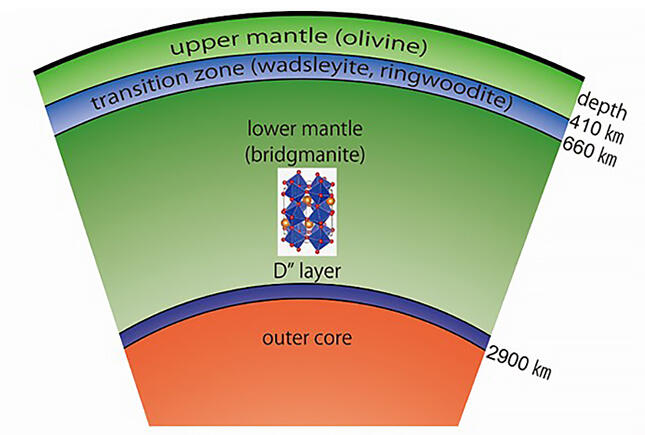A joint research group led by Assistant Professor Noriyoshi Tsujino, Associate Professor Daisuke Yamazaki and Professor Takashi Yoshino of the Institute for Planetary Materials, Okayama University, Professor Yu Nishihara of the Geodynamics Research Center, Ehime University, and chief researchers Yuji Higo and Yoshinori Tange of the Japan Synchrotron Radiation Research Institute (JASRI) has identified the viscosity of bridgmanite polycrystals, the most abundant mineral in the lower mantle of the Earth, by deformation experiments under high temperature and high pressure conditions.

Provided by Okayama University
To understand the motion of the Earth's interior, the research group focused on the mantle flow, particularly the flow properties of bridgmanite in the lower mantle, which makes up the bulk of the mantle, and investigated these properties using experimental techniques. Bridgmanite is a mineral that can exist stably above 23 GPa, which corresponds to the pressure conditions in the lower mantle. As such, it is essential to measure bridgmanite under high pressure conditions of 23 GPa or higher to directly study its deformation and flow.
The research group upgraded the Kawai-type multianvil apparatus, a large high-pressure generator, into a testing device capable of high pressure and deformation at the same time. In addition, they measured the stress and stain by combining stress and strain measurement techniques using high-brilliance X-rays obtained from the SPring-8 large synchrotron radiation facility and the High Energy Accelerator Research Organization (KEK)/PF-AR (a unique synchrotron radiation source facility that produces high-intensity pulsed synchrotron radiation), which enabled the measurement of viscosity during deformation experiments under high-temperature and high-pressure conditions that correspond to those in the lower mantle. Based on this technique, they were able to shed light on the viscosity of bridgmanite for the first time in the world.
Bridgmanite has been considered less viscous than the major minerals of the upper mantle and transition zone based on indirect method estimates, but the direct measurements in this study indicate that it has a higher viscosity than the other major mantle minerals. Based on the viscosity of bridgmanite, they found the stress conditions in the lower mantle and the grain size of bridgmanite to be 0.02-0.3 MPa and 3-8 mm, respectively.
The grain size of the bridgmanite indicates that the lower mantle is not convecting on a whole-mantle scale in unison with the upper mantle and transition zone, but that most of the lower mantle convects independently within it. The results support the recently proposed model of the Earth's internal evolution, in which the lower mantle is composed of ancient rocks rich in silicon dioxide.
"Moving forward, we will conduct experiments on mineral complexes that are closer to actual mantle materials, such as rocks and post-perovskite, which is the main constituent of the lowest part of the mantle," says Dr. Yamazaki. "As a result, we hope to develop a holistic understanding of mantle flow and, moreover, to identify the major constraints on global motion."
■ Bridgmanite: A mineral thought to be the most predominant mineral in the lower mantle (77% by volume), which extends 660 to 2,900 kilometers deep into the Earth's interior. Its main chemical composition is (Mg, Fe)SiO3 and has a perovskite-type crystal structure.
This article has been translated by JST with permission from The Science News Ltd.(https://sci-news.co.jp/). Unauthorized reproduction of the article and photographs is prohibited.




